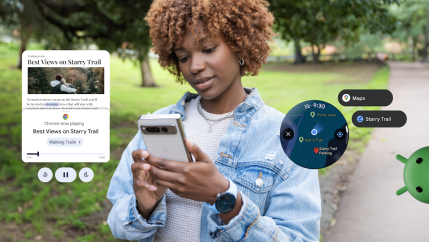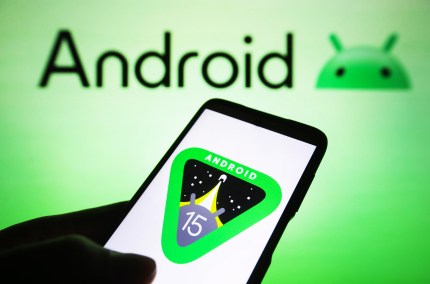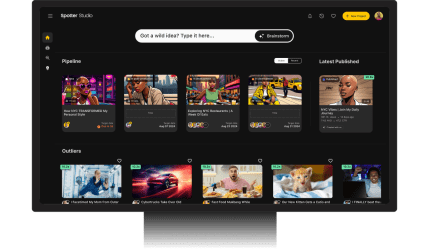Google’s long-promised, next-gen generative AI model, Gemini, has arrived. Sort of.
The version of Gemini launching this week, Gemini Pro, is essentially a lightweight offshoot of a more powerful, capable Gemini model set to arrive… sometime next year. But I’m getting ahead of myself.
Yesterday in a virtual press briefing, members of the Google DeepMind team — the driving force behind Gemini, alongside Google Research — gave a high-level overview of Gemini (technically “Gemini 1.0”) and its capabilities.
Gemini, as it turns out, is actually a family of AI models — not just one. It comes in three flavors:
- Gemini Ultra, the flagship Gemini model
- Gemini Pro, a “lite” Gemini model
- Gemini Nano, which is distilled to run on mobile devices like the Pixel 8 Pro*
*To make matters more confusing, Gemini Nano comes in two model sizes, Nano-1 (1.8 billion parameters) and Nano-2 (3.25 billion parameters) — targeting low- and high-memory devices, respectively.

The easiest place to try Gemini Pro is Bard, Google’s ChatGPT competitor, which as of today is powered by a fine-tuned version of Gemini Pro — at least in English in the U.S. (and only for text, not images). Sissie Hsiao, GM of Google Assistant and Bard, said during the briefing that the fine-tuned Gemini Pro delivers improved reasoning, planning and understanding capabilities over the previous model driving Bard.
We can’t independently confirm any of those improvements, I’ll note. Google didn’t allow reporters to test the models prior to their unveiling and, indeed, didn’t give live demos during the briefing.
Gemini Pro will also launch December 13 for enterprise customers using Vertex AI, Google’s fully managed machine learning platform, and then head to Google’s Generative AI Studio developer suite. (Some eagle-eyed users have already spotted Gemini model versions appearing in Vertex AI’s model garden.) Elsewhere, Gemini will arrive in the coming months in Google products like Duet AI, Chrome and Ads, as well as Search as a part of Google’s Search Generative Experience.
Gemini Nano, meanwhile, will launch soon in preview via Google’s recently released AI Core app, exclusive to Android 14 on the Pixel 8 Pro for now; Android developers interested in incorporating the model into their apps can sign up today for a sneak peek. On the Pixel 8 Pro first and other Android devices in the future, Gemini Nano will power features that Google previewed during the Pixel 8 Pro’s unveiling in October, like summarization in the Recorder app and suggested replies for supported messaging apps (starting with WhatsApp).
Natively multimodal
Gemini Pro — or at least the fine-tuned version of Gemini Pro powering Bard — isn’t much to write home about.
Hsiao says that Gemini Pro is more capable at tasks such as summarizing content, brainstorming and writing, and outperforms OpenAI’s GPT-3.5, the predecessor to GPT-4, in six benchmarks, including one (GSM8K) that measures grade school math reasoning. But GPT-3.5 is over a year old — hardly a challenging milestone to surpass at this point.
So what about Gemini Ultra? Surely it must be more impressive?
Somewhat.
Like Gemini Pro, Gemini Ultra was trained to be “natively multimodal” — in other words, pre-trained and fine-tuned on a large set of codebases, text in different languages, audio, images and videos. Eli Collins, VP of product at DeepMind, claims that Gemini Ultra can comprehend “nuanced” information in text, images, audio and code and answer questions relating to “complicated” topics, particularly math and physics.

In this respect, Gemini Ultra does several things better than rival OpenAI’s own multimodal model, GPT-4 with Vision, which can only understand the context of two modalities: words and images. Gemini Ultra can transcribe speech and answer questions about audio and videos (e.g. “What’s happening in this clip?”) in addition to art and photos.
“The standard approach to creating multimodal models involves training separate components for different modalities,” Collins said during the briefing. “These models are pretty good at performing certain tasks like describing an image, but they really struggle with more complicated conceptual and complicated reasoning tasks. So we designed Gemini to be natively multimodal.”
I wish I could tell you more about Gemini’s training datasets — I’m curious myself. But Google repeatedly refused to answer questions from reporters about how it collected Gemini’s training data, where the training data came from and whether any of it was licensed from a third party.
Collins did reveal that at least a portion of the data was from public web sources and that Google “filtered” it for quality and “inappropriate” material. But he didn’t address the elephant in the room: whether creators who might’ve unknowingly contributed to Gemini’s training data can opt out or expect/request compensation.
Google’s not the first to keep its training data close to the chest. The data isn’t only a competitive advantage, but a potential source of lawsuits pertaining to fair use. Microsoft, GitHub, OpenAI and Stability AI are among the generative AI vendors being sued in motions that accuse them of violating IP law by training their AI systems on copyrighted content, including artwork and e-books, without providing the creators credit or pay.

OpenAI, joining several other generative AI vendors, recently said it would allow artists to opt out of the training datasets for its future art-generating models. Google offers no such option for art-generating models or otherwise — and it seems that policy won’t change with Gemini.
Google trained Gemini on its in-house AI chips, tensor processing units (TPUs) — specifically TPU v4 and v5e (and in the future the v5p) — and is running Gemini models on a combination of TPUs and GPUs. (According to a technical whitepaper released this morning, Gemini Pro took “a matter of weeks” to train, with Gemini Ultra presumably taking much longer.) While Collins claimed that Gemini is Google’s “most efficient” large generative AI model to date and “significantly cheaper” than its multimodal predecessors, he wouldn’t say how many chips were used to train it or how much it cost — or the environmental impact of the training.
One article estimates that training a model the size of GPT-4 emits upwards of 300 metric tons of CO2 — significantly more than the annual emissions created by a single American (~5 tons of CO2). One would hope Google took steps to mitigate the impact, but since the company chose not to address the issue — at least not during the briefing this reporter attended — who can say?
A better model — marginally
In a prerecorded demo, Google showed how Gemini could be used to help with physics homework, solving problems step-by-step on a worksheet and pointing out possible mistakes in already filled-in answers.
In another demo — also prerecorded — Gemini was shown identifying scientific papers relevant to a particular problem set, extracting information from those papers and “updating” a chart from one by generating the formulas necessary to recreate the chart with more recent data.
“You can think of the work here as an extension of what [DeepMind] pioneered with ‘chain of thought prompting,’ which is that, with further instruction tuning, you can get the model to follow [more complex] instructions,” Collins said. “If you think of the physics homework example, you can give the model an image but also instructions to follow — for example, to identify the flaw in the math of the physics homework. So the model is able to handle more complicated prompts.”
Collins several times during the briefing touted Gemini Ultra’s benchmark superiority, claiming that the model exceeds current state-of-the-art results on “30 of the 32 widely used academic benchmarks used in large language model research and development.” But dive into the results, and it quickly becomes apparent that Gemini Ultra scores only marginally better than GPT-4 and GPT-4 with Vision across many of those benchmarks.

For example, on GSM8K, Gemini Ultra answers 94.4% of the math questions correctly compared to 92% in GPT-4’s case. On the DROP benchmark for reading comprehension, Gemini Ultra barely edges out GPT-4 82.4% to 80.9%. On VQAv2, a “neural” image understanding benchmark, Gemini does a measly 0.6 percentage points better than GPT-4 with Vision. And Gemini Ultra bests GPT-4 by just 0.5 percentage points on the Big-Bench Hard reasoning suite.
Collins notes that Gemini Ultra achieves a “state-of-the-art” score of 59.4% on a newer benchmark, MMMU, for multimodal reasoning — ahead of GPT-4 with Vision. But in a test set for commonsense reasoning, HellaSwag, Gemini Ultra is actually a fair bit behind GPT-4 with a score of 87.8%; GPT-4 scores 95.3%.
Asked by a reporter if Gemini Ultra, like other generative AI models, falls victim to hallucinating — i.e. confidently inventing facts — Collins said that it “wasn’t a solved research problem.” Take that how you will.
Presumably, bias and toxicity are well within the realm of possibility for Gemini Ultra too given that even the best generative AI models today respond problematically and harmfully when prompted in certain ways. It’s almost certainly as Anglocentric as other generative AI models — Collins said that, while Gemini Ultra can translate between around 100 languages, no specific work has been done to localize the model to Global South countries.

In another key limitation, while the Gemini Ultra architecture supports image generation (as does Gemini Pro, in theory), that capability won’t make its way into the productized version of the model at launch. That’s perhaps because the mechanism is slightly more complex than how, say, ChatGPT generates images; rather than feed prompts to an image generator (like DALL-E 3, in ChatGPT’s case), Gemini outputs images “natively” without an intermediary step.
Collins didn’t provide a timeline as to when image generation might arrive — only an assurance that the work is “ongoing.”
Rushed out the gate
The impression one gets from this week’s Gemini “launch” is that it was a bit of a rush job.
At its annual I/O developer conference, Google promised that Gemini would deliver “impressive multimodal capabilities not seen in prior models” and “[efficiency] at tool and API integrations.” And in an interview with Wired in June, Demis Hassabis, the head and co-founder of DeepMind, described Gemini as introducing somewhat novel capabilities to the text-generating AI domain, such as planning and the ability to solve problems.
It may well be that Gemini Ultra is capable of all of this — and more. But the briefing yesterday wasn’t especially convincing, and — given Google’s previous, recent gen AI stumbles — I’d argue that it needed to be.

Google’s been playing catch-up in generative AI since early this year, racing after OpenAI and the company’s viral sensation ChatGPT. Bard was released in February to criticism for its inability to answer basic questions correctly; Google employees, including the company’s ethics team, expressed concerns over the accelerated launch timeline.
Reports later emerged that Google hired overworked, underpaid third-party contractors from Appen and Accenture to annotate Bard’s training data. The same may be true for Gemini; Google didn’t deny it yesterday, and the technical whitepaper says only that annotators were paid “at least a local living wage.”
Now, to be fair to Google, it’s making progress in the sense that Bard has improved substantially since launch and that Google has successfully injected dozens of its products, apps and services with new generative AI-powered features, powered by homegrown models like PaLM 2 and Imagen.
But reporting suggests that Gemini’s development has been troubled.
Gemini — which reportedly had direct participation from Google higher-ups, including Jeff Dean, the company’s most senior AI research executive — is said to be struggling with tasks like reliably handling non-English queries, which contributed to a delay in the launch of Gemini Ultra. (Gemini Ultra will only be available to select customers, developers, partners and “safety and responsibility experts” before rolling out to developers and enterprise customers followed by Bard “early next year,” Google says.) Google doesn’t even understand all of Gemini Ultra’s novel capabilities yet, Collins said — nor has it figured out a monetization strategy for Gemini. (Given the sky-high cost of AI model training and inferencing, I doubt it’ll be long before it does.)

So we’re left with Gemini Pro — and very possibly an underwhelming Gemini Ultra, especially if the model’s context window remains ~24,000 words as outlined in the technical whitepaper. (Context window refers to the text the model considers before generating any additional text.) GPT-4 handily beats that context window (~100,000 words), but context window admittedly isn’t everything; we’ll reserve judgement until we’re able to get our hands on the model.
Could it be that Google’s marketing, telegraphing that Gemini would be something truly remarkable rather than a slight move of the generative AI needle, is to blame for today’s dud of a product launch? Perhaps. Or perhaps building state-of-the-art generative AI models is really hard — even if you reorganize your entire AI division to juice up the process.































Comment